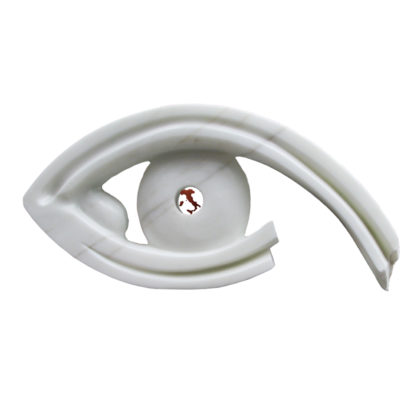
Guinea.
Piedra de Santanyí y madera.
Cm 68*58*13.
Vitíligo.
Es una enfermedad de la piel adquirida, crónica, de carácter autoinmune, que se caracteriza por la aparición de áreas despigmentadas bien delimitadas de la piel debido a la falta de función y pérdida de los melanocitos (las células responsables de la pigmentación). Las lesiones pueden ser de cualquier forma y tamaño y pueden afectar cualquier parte de la piel y también mucosas.
Las «lesiones» blancas resultantes del proceso citado, tienen un tamaño variable y su evolución y localización en las distintas partes del cuerpo no es previsible, si bien en el tipo de vitíligo que más predomina, el vitíligo simétrico, las lesiones tienden a aparecer a ambos lados del cuerpo en zonas similares. La textura de la piel no cambia. El vitíligo no es contagioso y sus consecuencias son fundamentalmente de carácter estético, y por tanto psicosocial.6
En el 40 % de los casos, el vitíligo es hereditario, si bien lo que se hereda es la predisposición genética, no la propia enfermedad. Para que esta se desarrolle tiene que concurrir, junto con la predisposición genética, un factor desencadenante. El vitiligo puede aparecer a cualquier edad, si bien en la mayor parte de las personas con esta predisposición genética, se da antes de los 20 años.
Prevalencia: 2 – 20 / 1000 .
Herencia: No aplicable.
Edad de inicio o aparición: Infancia, adolescencia, adulta.
Guinea.
Santanyí stone and wood.
Cm 68*58*13.
Vitiligo.
It is an acquired, chronic, autoimmune skin disease characterized by the appearance of well-defined depigmented areas of the skin due to the lack of function and loss of melanocytes (the cells responsible for pigmentation). The lesions can be of any shape and size and can affect any part of the skin and mucous membranes.
The white “lesions” resulting from the aforementioned process vary in size and their evolution and location in different parts of the body is not predictable, although in the most prevalent type of vitiligo, symmetrical vitiligo, the lesions tend to appear on both sides of the body in similar areas. The texture of the skin does not change. Vitiligo is not contagious, and its consequences are primarily aesthetic, and therefore psychosocial.6
In 40% of cases, vitiligo is hereditary, although it is the genetic predisposition that is inherited, not the disease itself. For the disease to develop, a triggering factor must be present along with the genetic predisposition. Vitiligo can appear at any age, although in most people with this genetic predisposition, it occurs before the age of 20.
Prevalence: 2 – 20 / 1000.
Inheritance: Not applicable.
Age of onset or appearance: Childhood, adolescence, adulthood.







